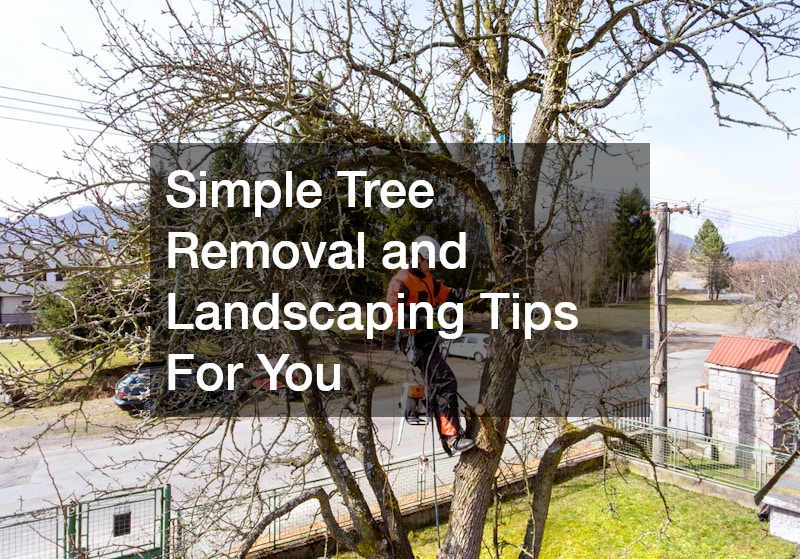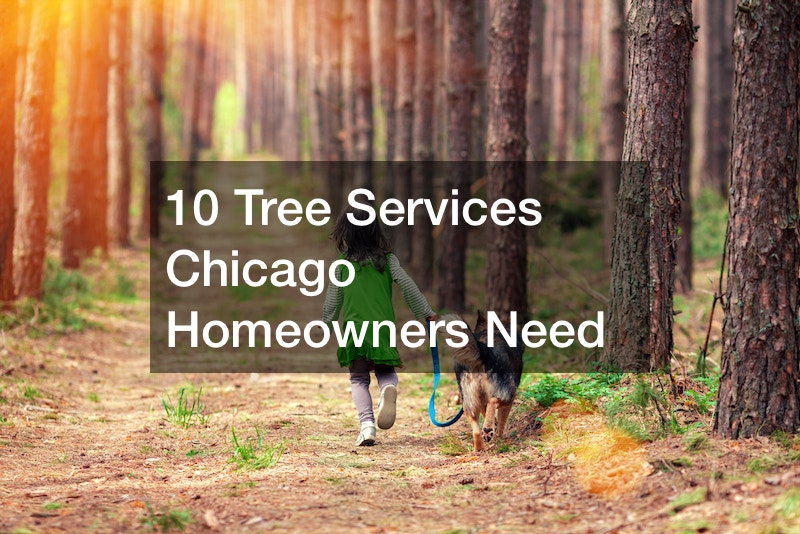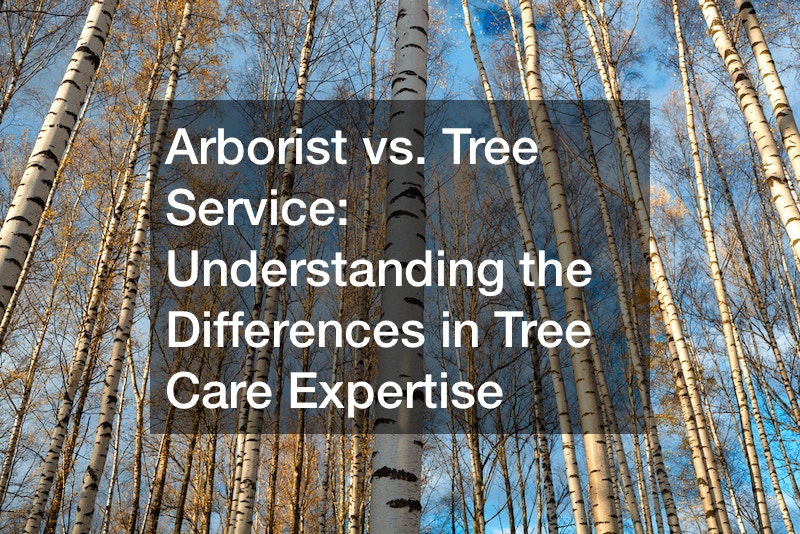When it comes to maintaining a beautiful and functional outdoor space, understanding the basics of tree removal and landscaping can make a significant difference. Whether you’re dealing with an overgrown tree threatening your property, clearing space for a new garden, or enhancing curb appeal with fresh landscaping, knowing how to approach these tasks efficiently can save time and effort. Removing a tree is more than just cutting it down—it requires careful planning to avoid damage to nearby structures and ensure safety. Hiring a professional arborist can be beneficial, especially for large trees or those close to buildings, as they have the expertise and equipment to handle the job safely. Similarly, effective landscaping involves choosing the right plants, maintaining healthy soil, and incorporating design elements that complement your home’s exterior. Native plants, for example, require less maintenance and water, making them an excellent choice for sustainable landscaping. Mulching, pruning, and regular lawn care can also contribute to a vibrant and well-maintained yard. With the right approach, you can transform your yard into a well-maintained and visually appealing space without unnecessary hassle. In this article, we’ll cover simple yet effective strategies for tree removal, ways to enhance your landscape, and essential tips to keep your outdoor area looking its best year-round. In this article, we’ll address common questions and provide insightful tips to help you manage your outdoor space efficiently. Let’s delve into the details!
Why is Tree Removal Necessary?

Tree removal is often necessary for maintaining the safety and aesthetics of a property. Certain trees become hazardous due to disease, structural damage, or age, making tree felling a priority to prevent accidents. By selecting appropriate tree services, property owners can ensure their landscape is safe and visually pleasing.
In many cases, tree removal and landscaping are crucial for preventing further damage to properties. Trees with compromised structures may fall on buildings, power lines, or block pathways, posing significant risks. Thus, understanding when to opt for tree services can help protect both people and property.
Moreover, tree removal can enhance the overall landscape design by eliminating elements that disrupt the harmony of the space. Employing the expertise of a tree trimming company ensures that the outdoor area is balanced and free from obstructions, ultimately increasing property value and functionality.
How to Determine if a Tree Needs to be Removed?
Determining the necessity of tree removal involves careful assessment of the tree’s health and location. Indicators such as dead branches, fungal growth, or severe bark damage may signal the need for tree felling. Regular inspection and consultation with tree services can aid in making informed decisions.
The proximity of a tree to critical structures is another factor to consider when deciding on tree removal and landscaping. Trees too close to a home, fence, or utility lines can cause structural damage or interrupt services. Professional evaluation from a tree trimming company can provide clarity on these issues.
Additionally, the overall health and stability of the tree play a crucial role in determining the need for removal. Trees that lean significantly, have hollow trunks or show signs of root damage should be assessed by experts. A comprehensive examination ensures that only trees that pose a threat are removed.
What are the Methods of Tree Removal?
There are several methods of tree removal depending on the tree’s condition and location. Standard tree felling involves cutting down the tree in sections, a common technique employed by tree services. This method is especially useful for trees situated in areas with ample space.
Another method often used in tree removal and landscaping is rigging. This involves the strategic lowering of tree parts using ropes and specialized equipment, minimizing damage to the surrounding landscape. Tree services frequently use this method for trees located close to buildings or other structures.
Cranes or aerial lifts are sometimes used to assist with tree removal, especially for large or inaccessible trees. These tools provide support and precision, ensuring that the tree is removed safely and efficiently. Selecting the appropriate method is crucial to achieving optimal results in tree removal and landscaping.
How to Choose a Tree Removal Service?

Selecting a professional tree removal service is paramount to ensuring quality and safety. When evaluating potential companies, it’s vital to assess their credentials and experience. A reputable tree trimming company should possess the necessary licenses and insurance to operate safely and legally.
Reading reviews and seeking recommendations from previous clients can also inform your decision. Experiences shared by others regarding tree removal and landscaping can provide valuable insights into the professionalism and efficiency of the service provider. Thorough research helps avoid hiring unreliable companies.
Price is another factor to consider, but it shouldn’t be the sole criterion for choosing a tree service. Quality of service is paramount, and opting for a cheaper, less experienced company may lead to additional costs or damage. Prioritize expertise and reputation to ensure successful tree removal and landscaping efforts.
What are the Best Practices for Stump Removal?
Once tree removal is complete, stump removal is the next step in the landscape transformation process. Hiring a stump removal service ensures that the task is handled professionally, as removing a stump can be complex and labor-intensive. Stump grinding is a popular technique, using specialized machinery to grind the stump down to below ground level.
Another method for stump removal in tree removal and landscaping is chemical treatment. This involves applying substances that accelerate stump decomposition, making it easier to remove. While slower than grinding, chemical treatment can be a cost-effective alternative.
It’s important to consider how stump removal will affect the surrounding landscape. Leaving a stump untreated can lead to regrowth or attract pests. Working with tree services to select the most appropriate stump removal method can preserve the integrity and appearance of your outdoor space.
How Does Landscaping Enhance Property Value?
Landscaping significantly increases property value by improving curb appeal and functionality. A well-maintained landscape not only enhances aesthetic appeal but can attract potential buyers, thus increasing the market value. Incorporating thoughtful tree removal and landscaping transforms ordinary yards into picturesque environments.
Beyond aesthetics, landscaping can create usable outdoor spaces that expand the functional area of a home. Features like patios, gardens, or walkways add versatility, making properties more attractive. An experienced landscaping or extermination service can assist in crafting these spaces.
Implementing sustainable landscaping practices also increases property value. Using native plants or investing in eco-friendly designs reduces maintenance costs and appeals to environmentally conscious buyers. Overall, tree removal and landscaping are essential for boosting both the liveability and resale value of a property.
What are Some Beginner Landscaping Tips?

For those new to landscaping, starting with a clear plan is essential. Defining your goals and budget can guide the selection of plants, materials, and features in your landscape design. Tree removal and landscaping should reflect both personal preferences and practical needs.
Another tip is to consult with pest control companies to ensure pest management is integrated into your landscaping plan. This prevents infestations that could damage plants or trees. Collaboration with professional tree services can also help in maintaining a healthy landscape.
Lastly, starting with small, manageable projects can prevent overwhelm. Focus on one section of your yard at a time, gradually building confidence and experience. Embarking on simple tasks, such as planting a flower bed or trimming bushes, can lay the foundation for more complex tree removal and landscaping projects.
How to Incorporate Hardscaping Features?
Incorporating hardscaping features involves using elements like stone, wood, or concrete to enhance the landscape. These features provide texture and structure, complementing the softer elements of plants and trees. Consulting professionals experienced in tree removal and landscaping ensure a cohesive design.
Common hardscaping features include patios, retaining walls, and pathways. Each element should be designed to suit the overall landscape function and aesthetics. Coordinating with bulk trash pickup services during installation can facilitate smooth integration and clean-up.
Keeping maintenance in mind is also crucial when adding hardscaping. Regular upkeep preserves their function and appearance, preventing issues like cracking or erosion. Partnering with tree services and using reliable materials can ensure longevity and harmony within your landscape.
How to Maintain a Landscape Over Time?
Consistency in landscape maintenance is key to sustaining its value and appearance over time. Scheduling regular tasks such as pruning, mowing, and cleaning can prevent issues from escalating. Tree removal and landscaping should involve ongoing care tailored to the specific needs of plants and features.
Incorporating services like recycling pick up into your maintenance routine can enhance efficiency and sustainability. Regular removal of green waste, in conjunction with professional tree services, supports a clean and healthy outdoor environment.
It’s also important to adapt maintenance practices to seasonal changes. Different plants and features require varying degrees of care throughout the year. Partnering with a knowledgeable cleaning company or landscaping service can provide valuable seasonal insights and assistance.
What are the Environmental Benefits of Landscaping?

Landscaping offers significant environmental benefits, from reducing erosion and improving air quality to supporting biodiversity. Thoughtful tree removal and landscaping can transform an ordinary yard into a thriving eco-friendly space. Trees and plants act as natural air filters, contributing to a healthier atmosphere.
Sustainable practices in landscaping, such as using drought-resistant plants or organic methods, conserve resources and decrease environmental impact. Consulting with a cleaning company can aid in maintaining these eco-friendly landscapes by employing green practices.
Moreover, creating habitats for local wildlife within a landscape supports biodiversity and ecological balance. Simple additions, like installing birdhouses or pollinator gardens, promote the presence of beneficial species. A strategic combination of tree services and ecological landscaping enhances these environmental advantages.
Incorporating These Tree Removal and Landscaping Tips
Maintaining a well-kept outdoor space requires a balance between strategic tree removal and landscaping efforts. Whether you’re clearing out hazardous trees, making room for a new project, or enhancing your yard’s overall appearance, having a plan in place ensures a smoother process. Thoughtful tree removal not only improves safety but also creates opportunities to reimagine your outdoor space with new plantings, hardscaping elements, or garden beds. Landscaping, on the other hand, is an ongoing process that involves everything from soil care to plant selection, irrigation, and seasonal maintenance. By incorporating proper techniques and sustainable practices, you can cultivate a beautiful and functional yard that thrives throughout the year.
One of the most important aspects of tree removal is assessing whether a tree truly needs to come down. If a tree is diseased, dead, or poses a risk to structures or utility lines, removal is the best course of action. However, in some cases, pruning and trimming may be a better alternative, helping to maintain the health and aesthetics of your landscape without drastic changes. When removal is necessary, hiring professionals ensures safety and efficiency, especially for large or difficult-to-reach trees. Professional arborists have the right tools and expertise to remove trees without causing unnecessary damage to the surrounding landscape. Once a tree is removed, stump grinding or removal prevents future growth issues and allows for new landscaping opportunities.
Beyond tree removal, landscaping requires careful planning to achieve a cohesive and visually appealing design. Selecting native plants, incorporating mulch to retain moisture, and designing outdoor spaces with functionality in mind all contribute to a balanced landscape. If you’re considering new trees or shrubs, be mindful of their mature size and root systems to prevent future issues with foundations, sidewalks, or underground utilities. Regular maintenance, including weeding, pruning, fertilizing, and aerating your soil, keeps your yard looking fresh and prevents overgrowth or nutrient depletion.
Ultimately, tree removal and landscaping go hand in hand when it comes to creating an outdoor space that is safe, attractive, and sustainable. By taking a proactive approach to tree maintenance, making thoughtful landscaping choices, and keeping up with regular care, you can maximize your yard’s potential while minimizing future problems. Whether you handle these tasks yourself or enlist the help of professionals, the key is to make informed decisions that enhance both the beauty and functionality of your property. With the right strategies in place, your outdoor space can remain a source of pride and enjoyment for years to come.




